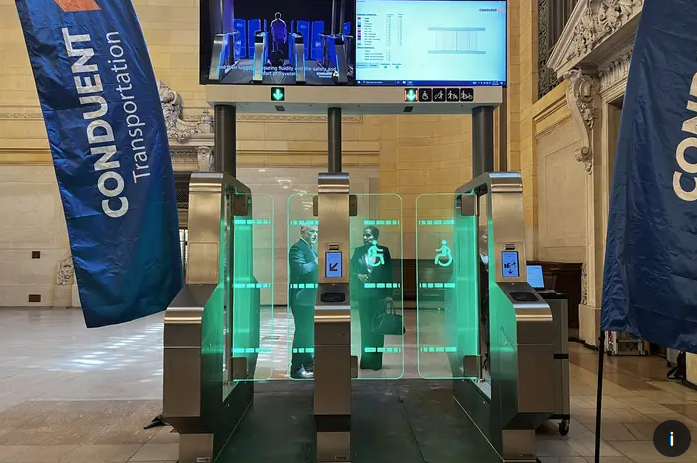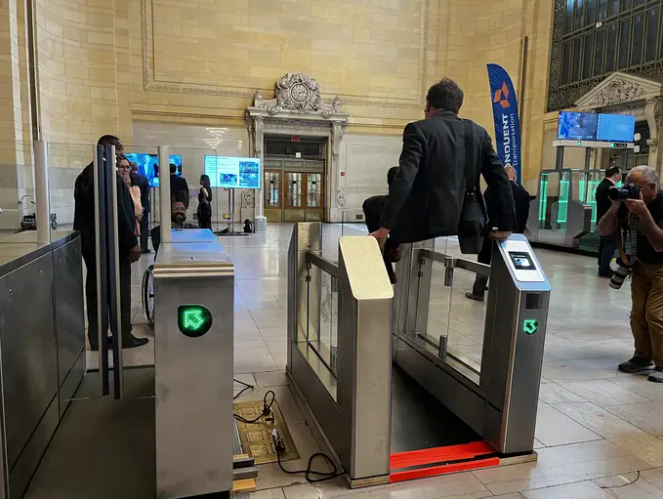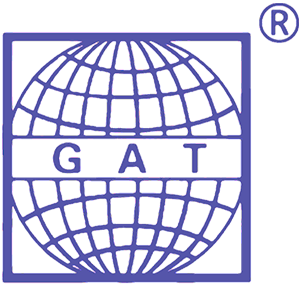MTA unveils new designs for subway turnstiles, reports $690M in fare and toll evasion

The MTA is planning the first major redesign of subway turnstiles in modern history, a change officials said is key to cracking down on fare evasion on the city’s mass transit system.
Prototypes of the new fare gate designs were on display at Grand Central Terminal on Wednesday. The equipment isn’t actually a turnstile that rotates as a straphanger passes through, but instead a pair of glass doors that slide open after a fare is paid. The gates resemble those in Paris’ subway system.
MTA Chair Janno Lieber said the new equipment would replace emergency exit doors in subway stations, which he said are the system's main source of fare evasion. There’s not yet a timeline for the overhaul of the turnstiles.
"When I grew up there was still the wood turnstiles," Lieber said. “Obviously, the installation of a whole new generation of turnstiles, of fare arrays, is going to take a while. But if anything is serious, you’ve got to get started.”

This newspaper reporter fell on his rear end after trying to jump over the MTA's new subway fare gate prototypes.
The plan to overhaul the fare gate is central to a report released by the MTA on a new initiative to prevent riders and drivers from skirting the agency’s fares and tolls. The plan was laid out in the agency’s new “Blue Ribbon Panel” report on fare evasion.
The report says the MTA lost an estimated $690 million last year to fare and toll evaders. Officials estimate subway fare evasion is responsible for $285 million of those losses. Commuter railroad riders flouting the fare cost $44 million and drivers evading the agency’s tolls cost $46 million, according to the report.
The report also estimated 37% of bus riders declined to pay the fare in the final three months of 2022 — and stated fare evasion on buses took $315 million out of the agency’s coffers last year.
“That is money that could be used to provide more service, more frequent service, more reliable service,” Lieber said. “It could be used to invest in infrastructure.”
Officials said they would focus on both “education” and enforcement to address the problem. The agency formed the blue ribbon panel as advocates raised concerns about historical racial disparities in fare evasion enforcement.
NYPD data showed 93% of people arrested for fare evasion in the subways during the final three months of 2022 were Black or Hispanic. And 66% of those issued summonses for fare evasion during that period were Black or Hispanic.
“We don’t want the police enforcing fare evasion on the buses, for example,” said Roger Maldonado, who co-chaired the panel that produced the report.
On the subways, he said “there should be a warning” the first time someone is caught evading the fare.
“It should be a documented warning, one where the person is told, ‘I’m letting you off this time, but the next time there will be consequences.’”
The panel members also said they planned state legislation that would tie the cost of fines issued to those who evade fares to their personal incomes.
Lieber said the MTA plans to speak with NYPD officials on the plan to crack down on fare evasion without racially targeting people of color.
“We’re going to keep working with the NYPD,” Lieber said. “They are part of his solution.”
Lieber also lambasted owners of "super luxury automobiles" who obscure their license plates to avoid paying bridge and tunnel tolls, and said MTA police have impounded dozens of high-end cars in the last six months.
"That is an outrage to ride around in a Bugatti or a Mercedes and try and stiff New Yorkers who are trying to get to school or work on the transit system," Lieber said.
